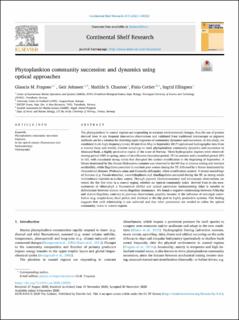| dc.description.abstract | The phytoplankton in coastal regions are responding to constant environmental changes, thus the use of proxies derived from in situ frequent time-series observations and validated from traditional microscopic or pigment methods can be a solution for detecting rapid responses of community dynamics and succession. In this study, we combined in situ high-frequency (every 30 min from May to September 2017) optical and hydrographic data from a moored buoy and weekly discrete samplings to track phytoplankton community dynamics and succession in Mausund Bank, a highly productive region of the coast of Norway. Three hydrographic regimes were observed: mixing period (MP) in spring, onset of stratification (transient period, TP) in summer and a stratified period (SP) in fall, with occasional strong winds that disrupted the surface stratification in the beginning of September. A bloom dominated by the diatom Skeletonema costatum was observed in the MP due to intense mixing and nutrient availability, while flagellates prevailed in nutrient-poor waters during the TP, followed by a bloom dominated by rhizosolenid diatoms (Proboscia alata and Guinardia delicatula), when stratification peaked. A mixed assemblage of diatoms (e.g. Pseudo-nitzschia), coccolithophores and dinoflagellates occurred during the SP, as strong winds reintroduced nutrients to surface waters. Through pigment (chemotaxonomy) and microscopic observations, we tested, for the first time in a coastal region, whether an ‘optical community index’ derived from in situ measurements of chlorophyll a fluorescence (Fchla) and optical particulate backscattering (bbp) is suitable to differentiate between diatom versus flagellate dominance. We found a negative relationship between Fchla:bbp and diatom:flagellate, contrary to previous observations, possibly because of the influence of non-algal contribution (e.g. zooplankton, fecal pellets and detritus) to the bbp pool in highly productive systems. This finding suggests that such relationship is not universal and that other parameters are needed to refine the optical community index in coastal regions. | en_US |

